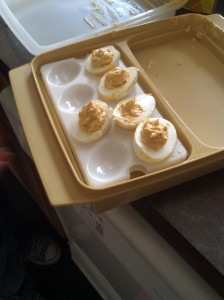Sriracha Deviled Eggs for Spring
I grew up in a family that made deviled eggs for special occasions. There was never a recipe. What I remember is a series of steps: boil eggs, peel eggs, halve eggs, put whites on fancy deviled-egg dish, put yolks in bowl, add mayonnaise, mustard, salt, pepper and horseradish as a matter of course, then possibly experiment with things like vinegar, hot sauce, and, one unfortunate time, wasabi. Make sure everyone in the house tastes it to offer input, then put into plastic bag, pipe into egg-white halves, and put leftover yolk mix on crackers, usually Triscuits.
As an adult on my own, I don’t make deviled eggs as often as my family does. My kids don’t (yet) like them. But yesterday on Easter, I felt the pull of tradition. I unearthed the Harvest Gold Tupperware egg transporter (I have three other egg serving dishes) and got down to the serious business of making eggs.
I was motivated by three recent articles–one from the Genius Recipes series at Food 52, and two from my husband G. Grod, one on baking eggs rather than boiling them, and another on using Sriracha sauce in the filling.
Baking versus boiling? A success. I put a cookie sheet below the baking eggs in case they ’sploded, but no eggs were harmed in the process. Were they easy to peel, you ask? More than half of them were, but easy-to-peel is more a function of egg age than of cooking method. I’ve tried poking a hole with a push pin, storing eggs on their sides, and pretty much all the methods, but the best thing is old eggs, where the inside membrane is drying out. Peeling under a thin stream of running water at the sink helps a bit by making a little space between the shell’s membrane and the egg.
Next up was making the filling. I only had a few eggs to work with, as I’d made the Hell’s Kitchen 9-egg lemon-ricotta hotcakes for breakfast, so I had to do some fiddly math to get proportions right, but they tasted good, with a nice slow burn at the finish. And they looked pretty and orange-y. Until they fell off G Grod’s cargo bike on the way to a friend’s house. We were able to rescue most of them, and I cleaned them up a bit for the below photo. In spite of their looks, they went fast. I’m going to make a lot more, next time. And not drop them.

Sriracha deviled eggs
Sriracha Deviled Eggs
1 dozen eggs, preferably about a week old
To cook the eggs: Put oven racks in middle of oven. In cold oven, place eggs directly on rack. (You can put a cookie sheet on the oven floor if you’re worried they’ll explode; mine didn’t.) Set oven to 325F. Set timer for 30 minutes. Prepare ice bath. When 30 minutes have passed, remove eggs with oven mitts or tongs and put them in ice bath for 5 minutes. When pouring out cold water, jostle eggs to crack the shells. Peel. Halve. Place egg whites on plate or tray.
For the filling:
12 egg yolks
6 tablespoons mayonnaise
2 tablespoons softened unsalted butter
2 teaspoons Dijon mustard
4 teaspoons Sriracha hot sauce
2 teaspoons fresh-squeezed lime juice
1/8 teaspoon kosher salt
1. Put yolks in mesh sieve over large bowl. With rubber spatula, press through mesh. Add mayonnaise, butter, mustard, Sriracha, lime juice and salt. Taste, and adjust as needed.
2. Transfer mixture to plastic bag. Snip off corner. Squeeze filling into egg whites on tray.
3. Eat the ugliest egg to make sure they’re good. Repeat as needed to reassure yourself. Share with friends. If you want to.
April 11th, 2012 at 7:52 am
Interesting twists on an old standard! I can’t remember the last time I had deviled eggs, but perhaps it’s time they made a comeback!
Question: any advantages to baking rather than boiling the eggs? Seems like boiling would take less time…
April 11th, 2012 at 8:20 am
I think the time isn’t so different–to bring eggs to boil and cover for 10 minutes. None of the baked eggs had a green tinge, which I still sometimes get with boiling, even with the bring em to a boil, cover for 10 minutes. It’s nice because I dont have to keep an eye on when that moment of boiling begins, and it saves a dish by not using a pot.